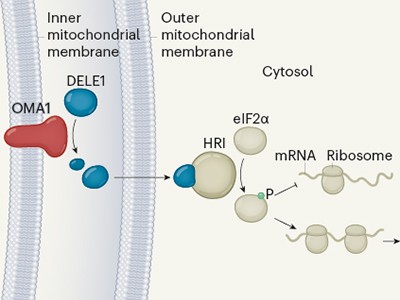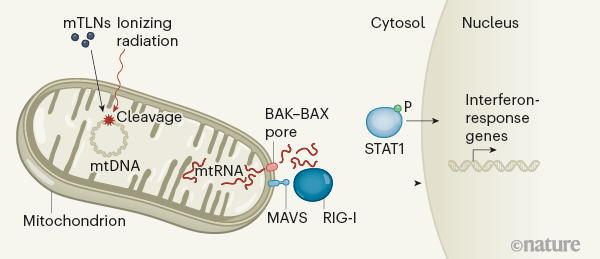This blog contains the mechanism to why I think the COVID vaccine is causing damage to those who get it. It is not what the anti-vaxxers think. The mechanism is 100% mitochondrial in nature. Let us get to it.
Growing evidence suggests that people with cancer and other conditions that challenge their immune systems may be incubators of mutant viruses. How?
Did you know that damage to DNA in a cellular organelle called the mitochondrion triggers an immune response in the nucleus? Mechanistic insights into this process shed light on how organelles communicate.
Mitochondria are membrane-bound organelles that act as hubs of metabolism and of innate immune signaling in cells. Each mitochondrion contains several copies of the mitochondrial genome (mtDNA), which can be damaged by extrinsic environmental stressors or intrinsic genetic mutations. This can cause degradation of the mtDNA, reducing the total number of mtDNA copies in the organelle and so leading to mitochondrial dysfunction. In addition, healthy mitochondrial function relies heavily on the crosstalk between mitochondria and the nucleus. Writing in Nature, Tigano et al. uncover a mechanism by which cells sense toxic mtDNA damage to initiate an immune response in the nucleus.
Conditions of acute stress, such as viral infection or irradiation, can lead to the activation of pro-death (apoptotic) pathways in the cell. Mitochondria have a key role in these pathways. Pore-forming proteins called BAK and BAX accumulate on the mitochondrial membrane, leading to the release of cell-death factors from the organelle into the cell’s cytosolic fluid through a process called mitochondrial herniation. In some instances, cell-death factors are not activated, in which case mitochondrial contents such as DNA and RNA are instead released into the cytosol. The accumulation of cytosolic mtDNA and mtRNA initiates a potent antiviral response. But precisely which aspects of mitochondrial dysfunction lead to the extrusion and accumulation of this mitochondrial material has been unclear.
Tigano et al. set out to examine one form of stress: cleavage of mitochondrial DNA. The group manipulated mammalian cells using ‘molecular scissors’ constructs called mitochondria-targeted TALENs (mTLNs), which generate double-strand breaks (DSBs) in mtDNA. They used RNA sequencing to analyze changes in gene expression in cells treated with mTLNs, and found an increased transcription of nuclear genes involved in the innate immune response; these included interferon-response genes, which are typically involved in combating viral infections. The authors also found that the transcription factor STAT1 was modified by phosphate groups and relocated to the nucleus — a key part of the interferon response.

Breaks in mtDNA that occur through other means, such as treatment with toxic, DNA-damaging agents or errors in replication, often lead to compromised organelle function. But Tigano and colleagues found that the mTLN treatment reduced the number of mtDNAs by only around 60%, which did not seem to have an immediate impact on mitochondrial function. The group observed no changes in key indicators of normal mitochondrial function, such as morphology, the gradient of protons (H+ ions) across the membrane, and the generation of reactive oxygen species. These data indicate that mitochondrial DNA cleavage is a key trigger of antiviral responses.
Next, Tigano et al. set out to identify the signaling molecules that relay the message of mtDNA instability to the nucleus. Although the mTLN-treated cells had intact mitochondrial function and were not apoptotic, the group showed that BAK–BAX pores did form on the membrane, consistent with mitochondrial herniation. The authors found that mtRNA — but not mtDNA — accumulated in the cytosol of these cells. The mtRNA molecules were detected by an RNA-sensing protein called RIG-I, which is better known as a sensor of viral RNA in the cytosol.
Working with its adaptor protein on the mitochondrial outer membrane, dubbed mitochondrial antiviral signaling (MAVS), RIG-I triggers a signaling pathway that activates interferon-response genes in the nucleus. These findings point to a framework by which cells engage mitochondrial signaling molecules in immune-surveillance mechanisms (Fig. 1).

Figure 1 | Communicating damage between organelles. Tigano and colleagues report a mechanism by which damage to DNA in an organelle called the mitochondrion is communicated to the nucleus. The group induced mitochondrial DNA (mtDNA) breaks, either by using ‘molecular scissors’ constructs called mitochondria-targeted TALENs (mTLNs) or through ionizing radiation. These treatments trigger the release of mtRNA into the cell’s cytosol through pores comprising BAK and BAX proteins. Two proteins — the cytosolic RNA sensor RIG-I, acting with its adaptor protein MAVS — sense the mtRNA, triggering signaling pathways that lead to the upregulation of genes involved in an immune response called the interferon response (dashed lines indicate an indirect effect). In addition, the transcription factor STAT1 is phosphorylated (P), and moves to the nucleus, where it might have a role in activating interferon-response genes.
DNA-damaging agents such as radiation, which is used to treat cancer, elicit a systemic immune response that is thought to be driven by DNA damage in the nucleus. Tigano and colleagues found that radiation depleted mtDNA numbers by 40% and elicited the same immune response as mTLNs, suggesting that DSBs occur in mtDNA as well as in nuclear DNA following irradiation. Strikingly, induction of the interferon response during irradiation was nearly completely abrogated in cells lacking mtDNA. This observation indicates that mtDNA damage caused by radiation can be a driver of interferon responses. Of note, the induction of several other innate immune responses still occurred in cells lacking mtDNA, suggesting that depletion of mtDNA specifically impairs the interferon response.
The study highlights an immunostimulatory role for mitochondrial RNA. However, questions remain. For instance, mtRNA molecules are highly unstable in nature — how are mtRNAs stabilized so that they accumulate in the cytosol, as was observed in the current study? Another avenue for further investigation is the factors that stimulate the formation of BAK–BAX pores following mtDNA breaks. It would be of broad interest to study whether drugs that inhibit this pore formation can suppress an inflammatory immune response. The discovery of a mechanism by which cells recognize self-RNAs from mitochondria to initiate an immune response also raises the question of whether this pathway might be involved in autoimmune disease. Finally, it would be exciting to explore whether artificially induced mtDNA damage could be used to increase the efficacy of targeted immunotherapies for cancer.
COULD THIS BE WHY THE COVID VACCINES ARE A PROBLEM?
Short answer……….yep.
Recall from above, mitochondria are membrane-bound organelles that act as hubs of metabolism and of innate immune signaling in cells. Tigano’s paper give us the mechanism of how mRNA engineering in the vaccines can go awry.
The current mRNA jab trials with emergency approval selected a dose that was too high, too far up on the sigmoidal dose-response curve – so we should expect a higher incidence of adverse events. The second mRNA problem is that the spike protein is the actual active agent causing damage, in terms of eliciting an immune response. This is the cytokine storm problem that causes the side effects of clotting and of heart failure due to mitochondrial damage. What causes the decreased energy transformation in the patient with side effects? The genetically modified spike protein. Therefore, the range and severity of adverse events potentially attributable to the level of expressed spike protein may reflect patient-to-patient differences due to their individual mitochondrial redox variability in genetic transfer efficiency and subsequent spike expression.
You might want to read this after the blog is assimilated as well. The perspective will fill out your understanding of what is really going on with censorship in science today. HYPERLINK
Natural genetic modification by the immune system to a pathogen is done with finesse and precision by our cell-mediated and innate immune arms themselves, without damaging the mitochondrial genome. In contrast, artificial genetic modification done in the laboratory by genetic engineers is crude, imprecise, uncontrollable, and ends up scrambling and damaging the mitochondrial genome with totally unpredictable effects on safety based upon what was translated from the mRNA. It also interferes inevitably with the natural genetic modification process, and that is ultimately why artificial genetic modification is inherently hazardous.
What can the average citizen do to get involved in the genetically modified vaccine debate?
Take it upon yourself to understand the science behind genetic engineering, expose the lies and half-truths you’ve been told; that’s how to learn real science, and it is fun. That is why you sign up here to be my patron. Don’t be intimidated by the ‘experts’. They are paid to shill for Big Pharma.

Life is simply to understand when you understand its wiring diagram.
Our colony of mitochondria is the primary producers of the body’s energy, mutations in their DNA alters the myriad of energy transformations that lead to size and shape changes inside of cells because altered energy levels cause the DNA to change their transcription of proteins and it is these small changes inside of cells that cause most human disease.
The idea is simple but has alluded modern medicine because of their Dunning Kruger moment of never realizing that the physics of organisms is all about energy transformations.
Space tells matter how to move and matter tells space how to curve and light follows this curve in space. Nature uses a science so queer to innovate living things which always causes outrage in physicians because it offends the common sense of the history medicine.
Waves do not describe a ‘real’ microworld but waves provide us ‘knowledge’ of how energy is traveling through spacetime and that is useful for making predictions in Nature
Humans who abuse technology perceive their world like they have an exemption from the competition of natural selection. They don’t. This paper in the hyperlink below explains it simply.
All of nature is a battlefield.
Life is just a series of wave forms that collides with matter after space has moved it.
Life is just the history we pay attention too, the rest is just the packaging. Change your focus and awareness you change your life.
Well, well the mainstream is catching up and Dr. Wallace getting his due. Now, when they realize the link between light, circadian biology, and mitochondrial function, then they can talk about the prevention/reversal of chronic disease. HYPERLINK
CITES:
1. Shpilka, T. & Haynes, C. M. Nature Rev. Mol. Cell Biol. 19, 109–120 (2018).
2. Guo, X. et al. Nature 579, 427–432 (2020).
3. Tigano, M., Vargas, D. C., Tremblay-Belzile, S., Fu, Y. & Sfeir, A. Nature591, 477–481 (2021).
4. McArthur, K. et al. Science 359, eaao6047 (2018).
5. White, M. J. et al. Cell 159, 1549–1562 (2014).
6. West, A. P. et al. Nature 520, 553–557 (2015).
7. Dhir, A. et al. Nature 560, 238–242 (2018).
8. Majoros, A. et al. Front. Immunol. 8, 29 (2017).
9. Alexeyev, M., Shokolenko, I., Wilson, G. & LeDoux, S. Cold Spring Harb. Perspect. Biol. 5, a012641 (2013).
10. Rehwinkel, J. & Gack, M. U. Nature Rev. Immunol. 20, 537–551 (2020).
11. Borowski, L. S., Dziembowski, A., Hejnowicz, M. S., Stepien, P. P. & Szczesny, R. J. Nucleic Acids Res. 41, 1223–1240 (2013).